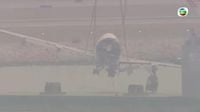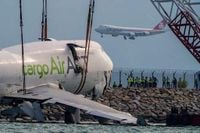In the early hours of Sunday, October 26, 2025, the main wreckage of a cargo plane that had dramatically veered off a Hong Kong runway and plunged into the sea was finally recovered from the waters. This marked a significant step in the ongoing investigation into a crash that has gripped the city and raised pressing questions about air safety, operations, and the tragic loss of life.
The incident unfolded on Monday, October 20, 2025, when a Boeing 747, operated by Turkey-based ACT Airlines and flying in from Dubai, attempted to land at Hong Kong International Airport. According to multiple reports from BBC News and CBS News, the aircraft skidded after touchdown, veered off the runway, and collided with a patrol car. The force of the impact sent both the massive cargo plane and the patrol car into the sea, a chilling scene that left two workers in the car dead. Miraculously, all four crew members aboard the plane escaped unharmed, though the psychological toll of such a near-disaster can hardly be overstated.
Steven Yiu, the airport authority’s executive director for airport operations, addressed the public in a somber news conference. He emphasized that, "weather and runway conditions met standards during the crash, while mechanical and human factors were yet to be investigated." This statement, reported by BBC News, underscored the complexity of the situation and the need for a thorough and impartial inquiry.
Salvage operations began almost immediately after the crash, but the full recovery of the wreckage was a painstaking process. Before crews could even attempt to lift the massive aircraft from the seabed, experts conducted an underwater sonar survey to map out the debris and ensure safety for divers and equipment. The runway where the accident occurred was temporarily closed, disrupting airport operations but deemed necessary to facilitate the recovery and investigation efforts.
By Friday, October 24, salvage teams had managed to lift the tail and other parts of the aircraft. Notably, they also recovered the flight data recorder and cockpit voice recorder—two crucial pieces of evidence that were promptly sent to a laboratory for preliminary examination. These devices are expected to provide investigators with vital information about the moments leading up to the crash, including the actions of the crew and the performance of the aircraft’s systems.
On Sunday, the front part of the fuselage was lifted from the water, with crews carefully adjusting its position in the air before slowly placing it onto a waiting vessel. The recovery operation was a delicate dance of engineering and precision, as any misstep could have further damaged the wreckage or endangered the lives of the salvage workers.
The Boeing 747 involved in the crash was operated under lease by Emirates, the renowned long-haul carrier based in Dubai. This detail, reported by Associated Press and CBS News, has brought additional international attention to the incident, with representatives from the U.S. National Transportation Safety Board and Turkey's Transport Safety Investigation Center joining the investigation alongside experts from Boeing. Their collective expertise is expected to be instrumental in piecing together the chain of events that led to the tragedy.
At the same news conference, Steven Yiu offered further details about the circumstances surrounding the crash. According to BBC News, he stated that airport officials had given the correct instructions to the plane and that there were signs on the runway to guide aircraft. He explained that the plane "turned off the runway and crashed through fencing alongside the path when it struck the patrol car, which was driving down a road on the opposite side of the fence." In a particularly telling remark, Yiu added, "Normally, the plane is not supposed to turn towards the sea." This admission has sparked speculation about possible mechanical failure, pilot error, or some combination of factors.
The city’s air accident investigation authority has promised to release a preliminary report within one month of the crash. This report is eagerly awaited by families of the victims, aviation professionals, and the public, all of whom are seeking answers—and perhaps some reassurance that such a disaster will not be repeated. In the meantime, the investigation continues, with officials meticulously examining every piece of evidence and every second of data recorded during the ill-fated flight.
The presence of international investigators underscores the seriousness with which the incident is being treated. The involvement of the U.S. National Transportation Safety Board, Turkey’s Transport Safety Investigation Center, and Boeing’s own experts reflects the interconnected nature of modern aviation and the shared commitment to uncovering the truth, no matter how uncomfortable it may be.
While the four crew members survived without physical injuries, the loss of two airport workers has cast a long shadow over the proceedings. Their families, friends, and colleagues are left mourning, and their deaths serve as a stark reminder of the risks faced by those who work on and around the world’s busiest runways. For Hong Kong, a city that prides itself on efficiency and safety, the incident has been a blow—but also a call to action.
As salvage crews completed their work and investigators pored over the recovered data, the city began to grapple with the broader implications of the crash. Was it a freak accident, or a sign of deeper issues in airport operations, training, or oversight? The fact that weather and runway conditions were within acceptable limits has only heightened the sense of urgency surrounding the investigation into mechanical and human factors.
For now, the answers remain elusive. The preliminary report, expected within a month, may shed light on what went wrong and offer recommendations to prevent future tragedies. Until then, the people of Hong Kong—and the global aviation community—wait, watch, and hope that the lessons learned from this disaster will lead to safer skies for all.





